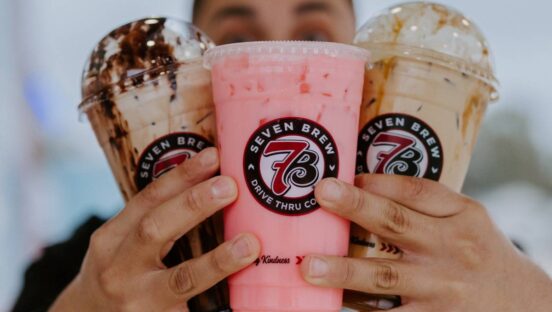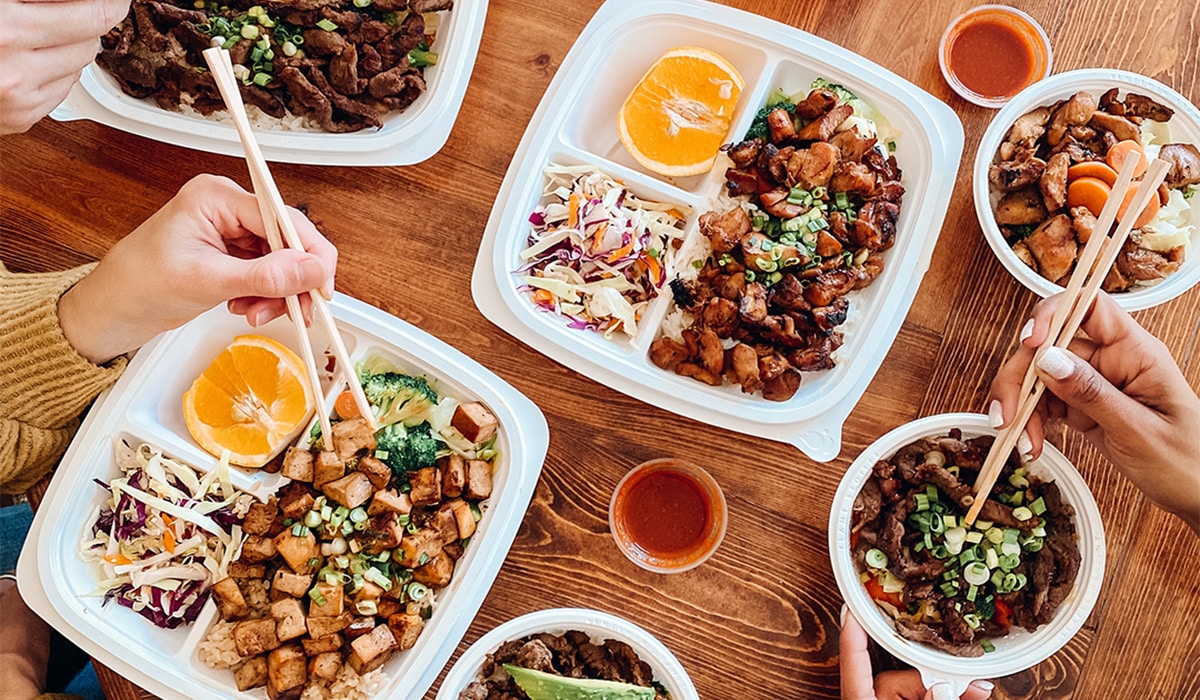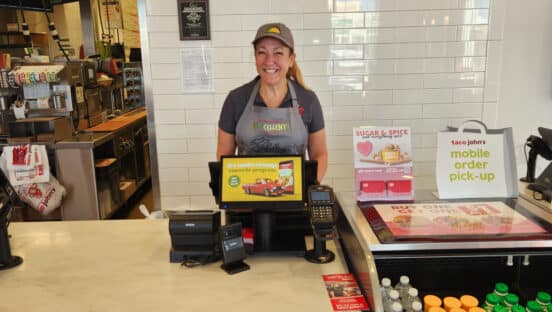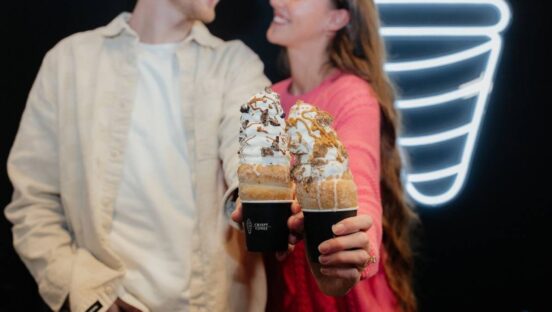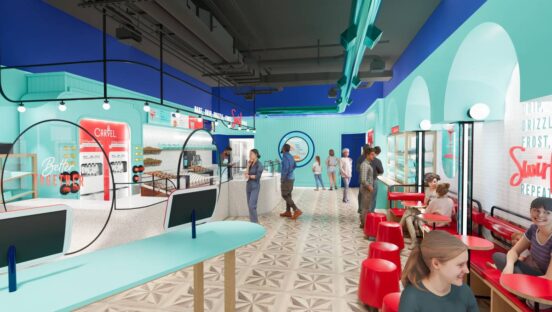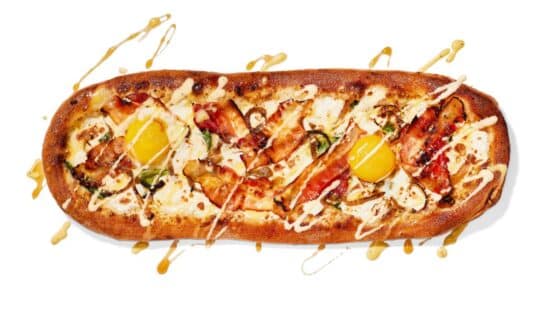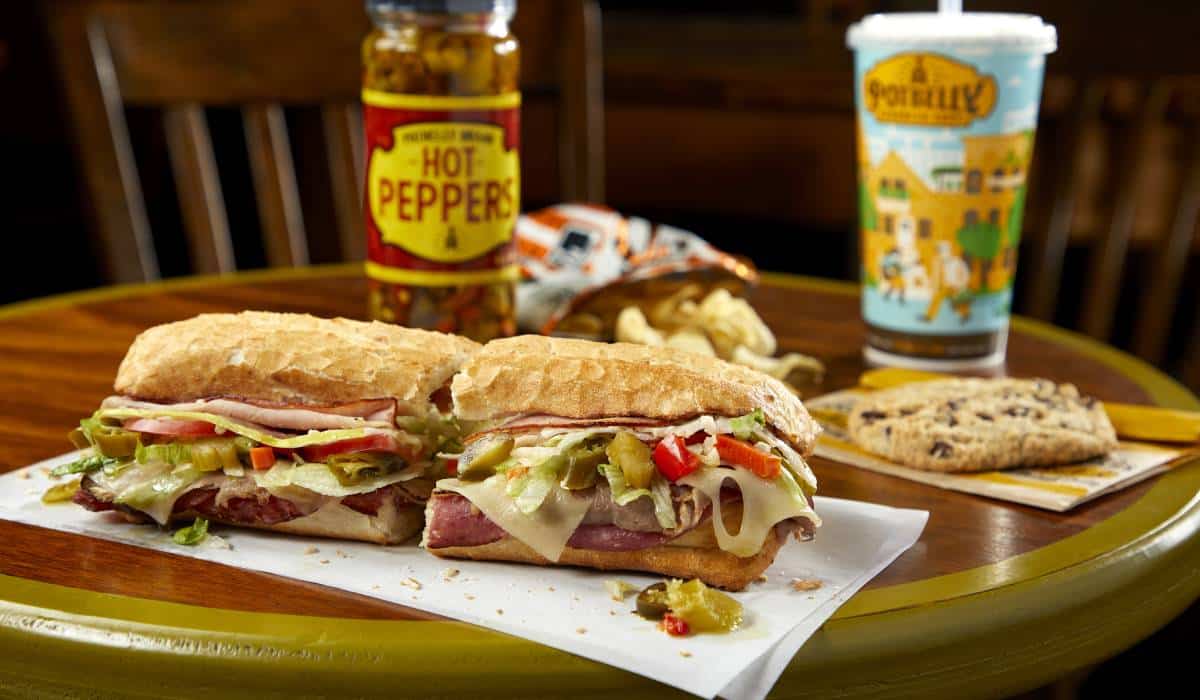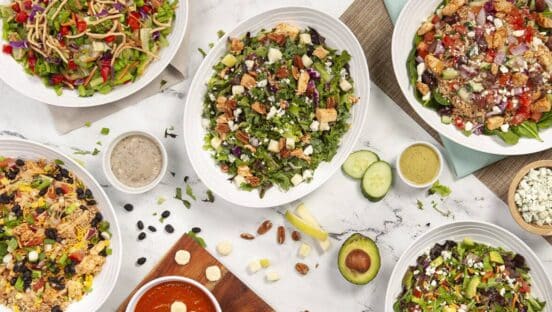Papa Johns CEO Rob Lynch has always tried to adhere to one of Walmart founder Sam Walton’s tried philosophies. “It’s not about how much we can charge—it’s about how little we can charge and achieve our financial objectives,” Lynch cites. From his earliest brainstorms as brand CEO in 2019, Lynch wanted Papa Johns to reemerge by accentuating its original differentiators—higher quality ingredients and a premium approach to a sector defined by value-driven monoliths.
If Walton’s adage feels counterintuitive, though. it’s simply because the parameters of “value” can’t be defined in a price-point box these days. “If you give [customers] a great deal, even if it’s not the cheapest deal, even if it’s not the lowest price point, people feel like they’re getting a good deal,” Lynch says. “That builds loyalty. We’re trying to build a brand. We’re not just trying to sell pizza.”
Over the past three years, Papa Johns has grown systemwide comparable sales in North America by 30 percent. This previous calendar marked the highest sales volume in the brand’s history, and Papa Johns rolled into 2023 off 11 quarters of industry outperformance.
That’s not to say the chain hasn’t hit macroeconomic and external roadblocks, many of which ring familiar across foodservice. Record-high costs and price sensitivity flashed in Q3 as the brand saw its same-store sales dip less than 1 percent in North America—the first negative spin since COVID delivered off-premises-centric brands nationwide, especially pizza, a multi-year headwind.
In response to 15–17 percent inflation, year-on-year, Papa Johns increased pricing 8–10 percent. While transactions dipped, Lynch feels it was more a function of elasticity of pricing than any hint of pizza fatigue. Global systemwide sales at Papa Johns rose 0.5 percent to $1.2 billion, a figure that lapped 11 percent growth in 2021.
But broadly, what the climate has done is force Papa Johns to take its brand lens and look through it again from a different angle. How could Papa Johns adjust its barbell for what’s become extreme sides of consumer response: value crunchers in a time of soaring costs; and those who feel experience is an affordable luxury they’re willing to dip into their pockets for.
BTIG analyst Peter Saleh recently surveyed more than 1,000 Papa Johns’ customers. The company found, to Lynch’s point, some consumers (lower-income in this poll) were dining out less often and reducing spend when they did so. However, it also discovered premium-priced items, like Papa Johns Stuffed Crust and Shaq-A-Roni, were equally, if not more, important to core customers of the brand.
Even with menu prices running 3–4X above historical norms in 2022, only a low-single-digit percentage of Papa Johns guests said they felt menu prices had become unreasonable. The data supported Lynch’s comments to a tee.

“I think if we can continue to launch great innovation at reasonable price points that people feel like they’re getting a good value and a good product at a good price, maybe not necessarily the lowest price, but a good, fair price, than I think we can continue to reinforce that positioning and succeed in the marketing piece,” Lynch says.
Of the 1,073 Papa Johns customers BTIG surveyed, just 42, or roughly 4 percent, gave a low value rating, while about 20 percent were neutral. Digging deeper, albeit a small subset of respondents for a chain with 3,356 North America units, it appears the consumers who feel Papa Johns prices have risen too much are mainly lower-income and from the South and Midwest. “Not surprisingly, consumers that gave Papa John’s the highest score on value tended to be higher-income, from households of three people or more,” Saleh said.
Returning to the barbell, Papa Johns’ premium DNA isn’t new. The brand’s Stuffed Crust platform continues to drive orders and some of the highest percentages of guests expressing intent to purchase in brand history. The product arrived in winter 2020, evolved into a pepperoni innovation, and has held steady in that $13.99 range. When Stuffed Crust was initially launched, “franchisees were ecstatic,” Saleh said, with operator checks suggesting the product was mixing about 25 percent. Nearly 40 percent of customers in BTIG’s survey reported they typically order Stuffed Crust. To recall, Stuffed Crust, Papa Pairings, Papa Bowls, NY Style Pizza, and Papadias, were not on the menu in 2019. So this innovation has flowed at a quick clip, and continuously.

The brand played further into premium with its super-sized Shaq-A-Roni product, which centers on the idea of “Shaq-flation.” A commercial emphasized that when other brands were “giving you less for more,” Papa Johns was giving you more (for more), with the 7-foot-1 Shaquille O’Neill at the controls. “There’s an insight there,” Lynch says. “People are still spending money on away-from-home food; they just don’t want to feel like they’re getting ripped off. At some point, you can only charge so much for the same cheeseburger or the same pizza or the same burrito. And the trick is figuring out how much that is without upsetting your customers.”
Papa Johns elects instead to surprise them.
“I think any time you can bring innovation that adds incremental value, you can charge a premium for, it’s going to be a lot more effective in driving your ticket growth than just charging more for the same [item],” Lynch says.
Papa Johns also maintained an approach of steering clear of national value messaging in favor of flexing market-to-market. Its co-ops boast funds to contribute into, so operators can manage local areas. This way, restaurants divert resources depending upon price sensitivity of customers in that region.
A value pivot
In September, Papa Johns introduced a more deliberate value spin. “Papa Pairings” bumped incremental transactions from the chain’s value-oriented guests by engaging them with an accessible price point.
Papa Parings is a $6.99 platform where diners pair two or more items. They can pick between a medium one-topping pizza, chicken poppers, Papadias, sides, and desserts. In the end, given guests need to buy two options, it ends up running a $14 check.
Since its arrival, per Saleh’s survey, the platform “has attracted significant customer attention.” About 20 percent of the Papa Johns customers polled said they tried it. There was also evidence Papa Pairings attracted new customers as it over-indexed with users earning less than $60,000 per year (Per BTIG data, Papa Johns’ typical customer brings in more than $75,000 per year). That said, in franchisee checks Saleh conducted, operators indicated consumer behavior with the platform adjusted of late, and that it was mixing about 15–20 percent. More guests have begun to trade down to Papa Pairings rather than use it as an add-on. “In our view,” Saleh said, “Papa Johns would rather have these customers trade down, rather than trade out.”
In other words, Papa Pairings has given the brand a beacon for incremental, value-driven customers who, amid higher prices, might have headed elsewhere. It elevated the consideration set and repeat potential.
Essentially, the dynamic lowers Papa Johns’ average check and increases the overall food cost, but retains the transaction that might have traded down to eating at home or another cheaper competitor. “Given the healthy mix, we believe this platform will become a permanent menu fixture for Papa Johns that could help drive consistent traffic and check growth for the brand, mirroring the results at Domino’s for over a decade,” Saleh said. “We note that historically, the average check for customers purchasing Domino’s Mix and Match value platform was higher than the overall average check, as consumers typically ordered more than the required two items.”
“We came out of the pandemic really establishing our product innovation as a strength in terms of reinforcing our premium positioning in the marketplace,” Lynch adds. “And as we got into the middle of this year, we started seeing more demand for value as the consumer sentiment went down, and as costs went up.”
That’s when Papa Pairings entered the picture.
Lynch says one of the reasons he feels it’s resonated is the structure represents a clear complement to Papa Johns’ core strategy. It’s a new entry point, but it doesn’t compromise the brand’s premium positioning. “We’ve essentially build a barbell strategy that allows us to continue to deliver premium products like Shaq-A-Roni and Pepperoni Stuffed Crust at price points we haven’t traditionally featured,” he says.
The barbell strategy has a firm place in quick-service lore. Since the financial crisis, Saleh pointed out, and the last major decline in consumers’ spending, nearly every fast-food brand, and many casual-dining operators for that matter, adopted a version of the barbell with lower-priced items designed to drive traffic alongside mid-tier and premium items designed to bolster average check. Papa Johns dove in aggressively. More recently, the company introduced Papa Bites at a $4.99 price point, which are offered in eight savory or sweet pockets of dough, rolled up with a guest’s choice of Chicken Parmesan, Jalapeño or OREO Cookie.
The broader picture, more growth ahead
Pizza has rode a roller-coaster since COVID landed. Brands from local delivery shops to category leaders rocketed to record performance on the back of two realities—customers turned to brands they already associated with takeout and delivery; and comfort food thrived during an uncomfortable time. This spike was difficult for every brand to maintain and then build on going into 2021 and 2021. But it was also the industry’s broad challenge to attract drivers that stalled performance. To put into perspective, Domino’s, because of Q1 staffing challenges, saw store hours reduced, phones go unanswered, and online orders get restricted. In all, the number of combined lost operating hours equated to the entire U.S. system being closed for six days.
Tack on commodity instability and how challenging taking price is in pizza overall, and Lynch says the pizza business faced a tougher dynamic than general quick service did.
Additionally, Q3 historically tends to be a slower delivery period as weather warms and people go on vacations. Fast food and drive-thrus benefit from summer road-trippers, but pizza does not; it sells in bad weather and as a weekday rescue outlet.
Lynch says Papa Johns is seeing commodity inflation flatten and hopes there will be some positive downward movement in the cost structure this year. Yet the brand isn’t going to bake that hope into its cadence.
“What I want to express to our teams is we need to stay laser focused on what we can control,” Lynch says. “We can’t control what’s going to happen in China and lockdowns and the COVID situation … We can’t control how long a conflict in Ukraine or anywhere else is going to happen. So we need to stay focused on what we can control.”
That’s what Papa Johns did throughout 2022. The brand improved operations, became more productive, and worked on a value platform that would weather external forces.
“We’ve been very focused on our speed of service,” Lynch says. “Very focused on the customer experience that we’re delivering, through the ordering process and our digital channels. But also, through the execution process in terms of how long it takes to get the hot pizza to guests and the customer recovery when things don’t go perfect. We’re making sure that we are best in class across all of those things.”
Papa Johns is up to nearly 28 million loyalty members. Also ahead of the curve, the brand entered 2023 having worked with third-party delivery aggregators going on two to three years, depending on the service. It’s a strategy that’s helped Papa Johns meet guests where they are and open an incremental channel. Of course, it’s also given operators the ability to leverage third-party delivery capabilities, particularly at peak times.
“Our most valuable customers come through our loyalty channels,” Lynch says, “and two-thirds of the customers who come through the aggregators are incremental and are helping to drive that loyalty number. We see them come from aggregator initial usership to more of our organic channels.”
Papa Johns today has a better grip on the labor situation and its totality. It’s developed expertise around scheduling its own drivers while complementing organic ones with the delivery as a service during rush times where there’s more demand than Papa Johns has capacity to serve. Lynch says the labor market isn’t where it was, but it’s definitely recovered from the trough last January when Omicron left restaurants staffed at about 50 percent.
“We haven’t gotten all of the way back, but we have seen some improvement at the macro level in terms of the people and the pool,” he says. “But I think we have disproportionally improved our labor situation by just getting better at how we utilize our labor and how we allocate our hours across the business model in terms of dayparts and days of the week and how we complement our organic model with the aggregators that we partner with.”
One example is the brand’s call center structure, including the AI-driven “PapaCall” unveiled in August 2021. Call centers haven’t necessarily taken labor out of restaurants, yet they have allowed Papa Johns to reallocate hours that would have been spent answering calls to making pizzas and, at times, to widening delivery capacity. “Between the PapaCall and our digital ordering platforms and our partnerships with the aggregators, I feel like we’ve been best-in-class in managing through these labor challenges, which, is, at least in part, why I think we’re going to be pretty much the only pizza company that’s going to comp positive this year,” he says.

Saleh surveyed customers on this topic, too. When BTIG asked the least frequent Papa Johns customers what would get them to order more often, it found just 7 percent said faster delivery times, while 21 percent would order more often if the restaurant were closer to their home or office. The survey also recognized about 7 percent of customers were ordering Papa Johns through a third-party aggregator. “With the recent shift in consumer preference to carryout versus delivery across the industry, we were not surprised to see 21 percent of consumers indicating that they would be more frequent customers if the restaurant were closer to home or office,” Saleh added, in what could be a sign of the price climate. “Carryout has posted double-digit gains this year at the expense of delivery, as consumers look to save a few dollars of their spending. Our survey suggests that about half of the transactions are now carryout, up from low 40 percent historically.”
Papa Johns ended Q3 with 5,589 stores globally, including 3,358 in North America and 2,231 internationally. A net of 18 units opened across the world in the quarter. The brand expects to open a total of 240 to 260 locations across the fiscal year and reach a multi-year goal to grow net new units by 1,400–1,800 between 2023 and 2025.
Papa Johns will open more than 400 restaurants in 2023, Lynch says.
If the market normalizes and brands witness margin accreditation, development should tick up. As other operators have suggested, it’s a reality that might just take some time.
When it arrives, though, Lynch believes the lasting effect of COVID will be clear in Papa Johns’ playbook. The ROI on a $500,000 or so build (compared to the $1.5–$2 million seen in many freestanding drive-thru quick-serves) will surface. Average-unit volumes at North American Papa Johns locations sat at more than $1.1 million in Q3 and continue to grow. The number is 30 percent better than 2019.
And what also will pop has nothing to do with global economies or how long it might take for U.S. spending patterns to right ship, Lynch says. “What I do know is that we’re a better company today than we were a year ago or three years ago,” he says. “And that’s what gets me really excited versus the day in and day out dealing of the costs and the challenges. We just try to stay focused on what we can control, and I think we’re building a company that’s going to continue to outperform for the long term.”


